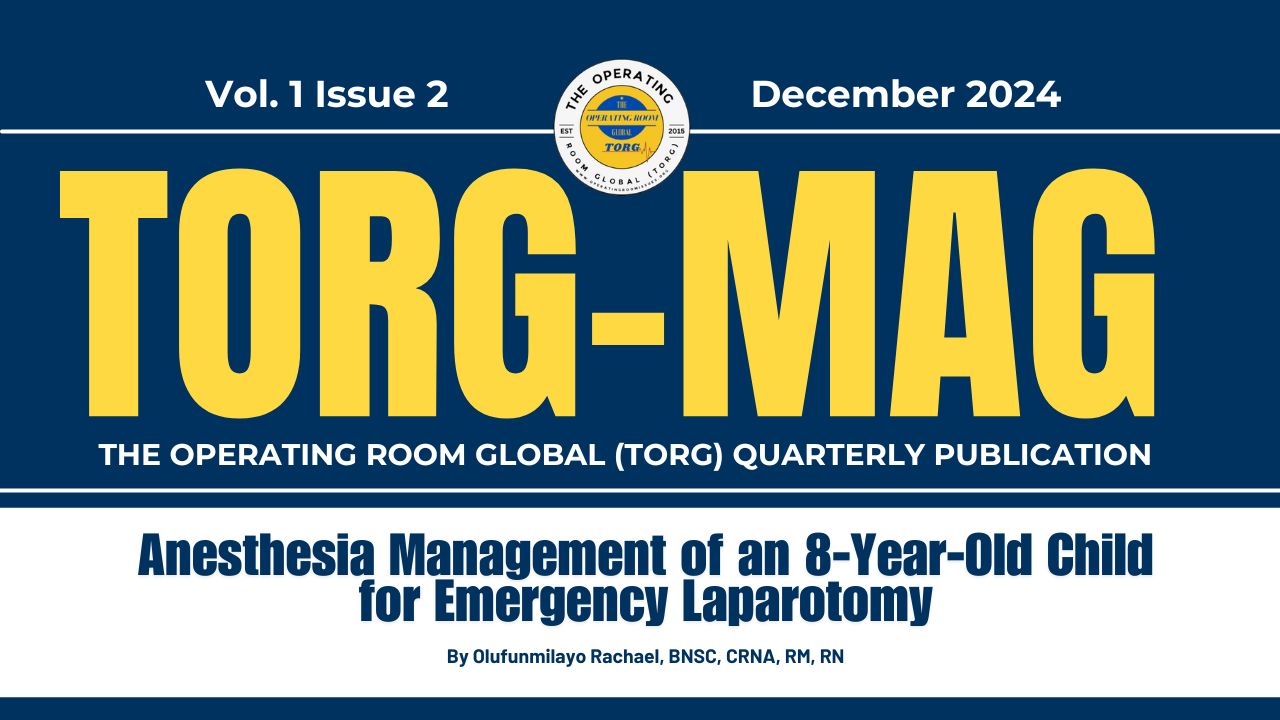TORG-MAG Vol 1 Issue 2, Dec. 2024, pp. 31-32.
By Olufunmilayo Rachael, BNSC, CRNA, RM, RN
Cite this article: Olufunmilayo, R. (2024) ‘Anesthesia Management of an 8-Year-Old Child for Emergency Laparotomy’, TORG-MAG, Vol. 1, Issue 2, pp. 31-32. Available at: https://torgevents.org/anesthesia-management/
Abstract

An 8-year-old girl was referred from a peripheral hospital due to a 2-day history of abdominal distention and a 1-day history of abdominal pain. She was admitted to the pediatric surgical ward with a diagnosis of intestinal obstruction. Conservative management was initiated, including nil per oral, intravenous fluids, antibiotics, and monitoring of vital signs. Investigations, including ultrasound, blood tests, and cross-matching, were conducted. After evaluation, the patient was scheduled for an emergency laparotomy. Informed consent was obtained from her father. The surgery was successfully performed under general anesthesia, and both intraoperative and postoperative conditions were satisfactory.
Case Presentation
An 8-year-old girl, previously in good health, presented with progressive abdominal distention and severe, colicky abdominal pain of 2 days duration. The pain worsened with food intake and was relieved by vomiting, which was non-projectile, non-bilious, and non-bloody. She experienced multiple episodes of vomiting and developed constipation. There was no history of trauma, fever, or reduced urine output. She had undergone two previous laparotomies, 4 months and 2 months prior, for suspected typhoid perforation and complications from the first surgery, respectively.
On physical examination, the patient was afebrile, pale, and anicteric. She had a distended abdomen with a rough midline scar. A rectal exam showed normal sphincter tone and no abnormalities. Initial investigations included full blood count, electrolytes, urea, creatinine, and ultrasound. The ultrasound revealed marked dilatation of the large bowel with ascites. A diagnosis of intestinal obstruction due to postoperative adhesions was made. After worsening symptoms, including tachycardia, tachypnea, and fever, the patient was booked for an emergency exploratory laparotomy.
Management
Pre-Anesthetic Assessment
The patient had no history of hypertension, diabetes, asthma, seizures, or sickle cell disease, and no known drug allergies. She was pale but well-hydrated and afebrile (37.6°C). Airway examination showed no abnormalities, and her Mallampati score was II. Pulse rate was 140 beats per minute, respiratory rate was 30 cycles per minute, and SpO2 was 97%. Laboratory investigations revealed mild electrolyte imbalances, and her ASA classification was II E (emergency).
Pre-Operative Preparation
The patient was received into the theatre, and standard checks on anesthesia equipment were performed. Drugs were calculated based on her weight (22 kg). Pre-medications included glycopyrrolate, ondansetron, paracetamol, ceftriaxone, and metronidazole. Induction agents used were propofol, ketamine, and suxamethonium, and maintenance was done with isoflurane and fentanyl. Intravenous fluids were administered, and blood loss replacement was planned.

Intra-Operative Management
The patient was positioned supine, and intravenous access was established. Monitoring devices were attached, and baseline vitals showed blood pressure of 117/84 mmHg, heart rate of 156 beats per minute, and SpO2 of 98%. Pre-oxygenation was done, and rapid sequence induction was carried out using ketamine, propofol, and suxamethonium. A cuffed 6-mm endotracheal tube was successfully inserted, and controlled ventilation commenced.
Anesthesia was maintained with isoflurane and fentanyl. Monitoring was continuous throughout the procedure. Total intravenous fluid administered was 350 ml, and the estimated blood loss was 100 ml. The patient received 200 ml of blood transfusion and remained stable during the 2-hour surgery.
At the conclusion of the procedure, the endotracheal tube was removed, and the patient was extubated in a deep state. She was transferred to the recovery room with stable vitals. The laparotomy revealed a 12 cm necrotic section of the transverse and descending colon, which was resected, followed by colonic anastomosis.
Post-Operative Management
Postoperatively, the patient was monitored closely in the recovery unit. She was maintained on intravenous fluids and broad-spectrum antibiotics, and her nasogastric tube was discontinued after 48 hours. She began early ambulation and resumed oral intake 48 hours post-surgery. The patient made a satisfactory recovery and was discharged home on the 8th postoperative day.
Conclusion
This case highlights the importance of timely intervention and the effective management of pediatric patients requiring emergency laparotomy. Close perioperative monitoring, appropriate anesthesia, and postoperative care are critical to ensuring positive outcomes in such cases.
TORG Magazine (TORG-MAG)
TORG-MAG Vol 1 Issue 2, Dec. 2024
(Innovating for Tomorrow: The Future of Global Surgical Excellence)
Stay ahead in the field of surgical practice with TORG-MAG, the quarterly publication from The Operating Room Global (TORG).
✓ Fill out the Form Below and submit
